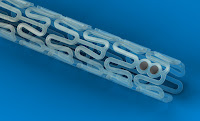Know about the latest types of stents used to remove heart blockage along with the standard types of stents.
A stent is a meshed tube which is implanted in heart patients to open a blockage in the artery. Stents, when implanted in an artery, act as scaffold to keep the blocked blood vessel open. There are more than one type of stent that are used to clear heart blockage in patients.
A stent is a meshed tube which is implanted in heart patients to open a blockage in the artery. Stents, when implanted in an artery, act as scaffold to keep the blocked blood vessel open. There are more than one type of stent that are used to clear heart blockage in patients.
Plain Old Balloon Angioplasty (POBA)
Balloon angioplasty is the first milestone for treatment of blockage in heart. Percutaneous transluminal coronary angioplasty, popular by the name of balloon angioplasty, was introduced way back in 1977 and uses a balloon to open the blocked artery. However, blockage recurrence rate in it was 35-50 percent. The latest development regarding balloon angioplasty includes ongoing clinical trials for drug eluting balloons.
Balloon angioplasty is the first milestone for treatment of blockage in heart. Percutaneous transluminal coronary angioplasty, popular by the name of balloon angioplasty, was introduced way back in 1977 and uses a balloon to open the blocked artery. However, blockage recurrence rate in it was 35-50 percent. The latest development regarding balloon angioplasty includes ongoing clinical trials for drug eluting balloons.
Bare Metal Stents (BMS)
These conventional stents are made of stainless steel. In about 20 percent of cases of angioplasty, bare metal stents are implanted and stay in artery for lifetime. The latest developments regarding BMS have seen the launch of a mesh based coronary stent which has an embolic protection device claiming to reduce injury during the stent implantation procedure. It is also claimed to lower the risk of restenosis or the recurrence of stenosis which restricts blood flow.
These conventional stents are made of stainless steel. In about 20 percent of cases of angioplasty, bare metal stents are implanted and stay in artery for lifetime. The latest developments regarding BMS have seen the launch of a mesh based coronary stent which has an embolic protection device claiming to reduce injury during the stent implantation procedure. It is also claimed to lower the risk of restenosis or the recurrence of stenosis which restricts blood flow.
Drug- Eluting Stents (DES)
These are considered the second generation stents and are coated with medicines that prevent formation of blood clots (thrombosis) immediately after the procedure. They are used in 80 percent of the patients having heart blockage. Latest developments are the metal DES with bio-absorbable- polymer or resorbable polymer. These stents make the patients capable of avoiding double anti-platelet drugs (double blood thinners).
These are considered the second generation stents and are coated with medicines that prevent formation of blood clots (thrombosis) immediately after the procedure. They are used in 80 percent of the patients having heart blockage. Latest developments are the metal DES with bio-absorbable- polymer or resorbable polymer. These stents make the patients capable of avoiding double anti-platelet drugs (double blood thinners).
Bioresorbable Vascular Scaffold (BVS)
The bioresorbable stents are made of polylactide- a bio- compatible material that is generally used in dissolving sutures. Unlike BMS and DES, bioresorbable stents are gradually absorbed by the body and dissolve within two years. Therefore, patients need not be kept on blood thinners for very long. Also, as the implant is not left in the body permanently, the vessel may have the ability to move, flex and pulsate just like an untreated normal vessel. BVS are still in clinical trial phase.
The bioresorbable stents are made of polylactide- a bio- compatible material that is generally used in dissolving sutures. Unlike BMS and DES, bioresorbable stents are gradually absorbed by the body and dissolve within two years. Therefore, patients need not be kept on blood thinners for very long. Also, as the implant is not left in the body permanently, the vessel may have the ability to move, flex and pulsate just like an untreated normal vessel. BVS are still in clinical trial phase.





Tidak ada komentar